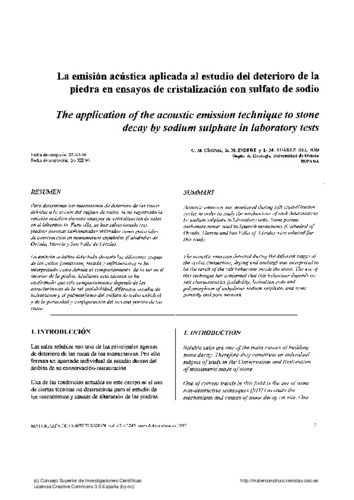La emisión acústica aplicada al estudio del deterioro de la piedra en ensayos de cristalización con sulfato de sodio
Otros títulos:
The application of the acoustic emission technique to stone decay by sodium sulphate in laboratory test
Autor(es) y otros:
Fecha de publicación:
Citación:
Descripción física:
Resumen:
Para determinar los mecanismos de deterioro de las rocas debidos a la acción del sulfato de sodio, se ha registrado la emisión acústica durante ensayos de cristalización de sales en el laboratorio. Para ello, se han seleccionado tres piedras porosas carbonatadas utilizadas como materiales de construcción en monumentos españoles (Catedrales de Oviedo, Murcia y Seo Vella de Lérida). La emisión acústica detectada durante las diferentes etapas de los ciclos (inmersión, secado y enfriamiento) se ha interpretado como debida al comportamiento de la sal en el interior de la piedra. Mediante esta técnica se ha confirmado que este comportamiento depende de las características de la sal (solubilidad, diferentes estados de hidratación y el polimorfismo del sulfato de sodio anhidro) y de la porosidad y configuración del sistema poroso de las rocas.
Para determinar los mecanismos de deterioro de las rocas debidos a la acción del sulfato de sodio, se ha registrado la emisión acústica durante ensayos de cristalización de sales en el laboratorio. Para ello, se han seleccionado tres piedras porosas carbonatadas utilizadas como materiales de construcción en monumentos españoles (Catedrales de Oviedo, Murcia y Seo Vella de Lérida). La emisión acústica detectada durante las diferentes etapas de los ciclos (inmersión, secado y enfriamiento) se ha interpretado como debida al comportamiento de la sal en el interior de la piedra. Mediante esta técnica se ha confirmado que este comportamiento depende de las características de la sal (solubilidad, diferentes estados de hidratación y el polimorfismo del sulfato de sodio anhidro) y de la porosidad y configuración del sistema poroso de las rocas.
Acoustic emission was monitored during salt crystallisation cycles in order to study the mechanisms of rock deterioration by sodium sulphate in laboratory tests. Some porous carbonate stones used in Spanish monuments (Cathedral of Oviedo, Murcia and Seo Vella of Lérida) were selected for this study. The acoustic emission detected during the different stages of the cycles (immersion, drying and cooling) was interpreted to be the result of the salt behaviour inside the stone. The use of this technique has confirmed that this behaviour depends on salt characteristics (solubility, hydration state and polymorphism of anhydrous sodium sulphate) and stone porosity and pore network.
Acoustic emission was monitored during salt crystallisation cycles in order to study the mechanisms of rock deterioration by sodium sulphate in laboratory tests. Some porous carbonate stones used in Spanish monuments (Cathedral of Oviedo, Murcia and Seo Vella of Lérida) were selected for this study. The acoustic emission detected during the different stages of the cycles (immersion, drying and cooling) was interpreted to be the result of the salt behaviour inside the stone. The use of this technique has confirmed that this behaviour depends on salt characteristics (solubility, hydration state and polymorphism of anhydrous sodium sulphate) and stone porosity and pore network.
Ficheros en el ítem




